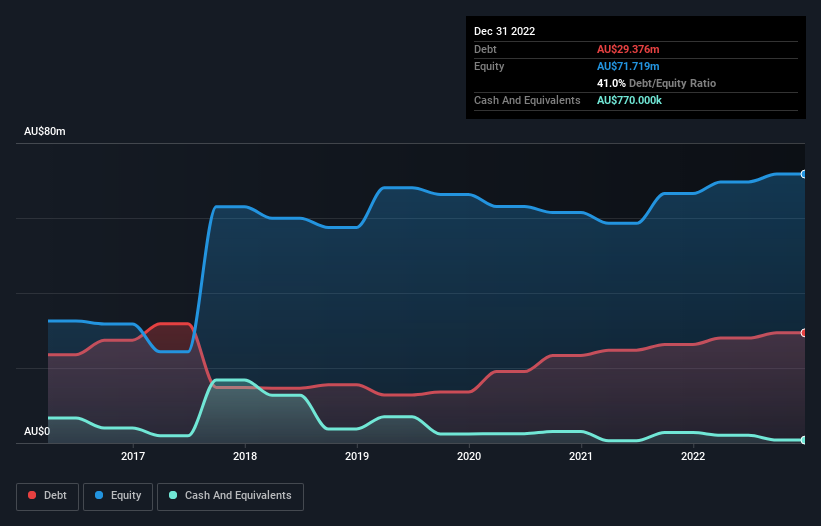
David Iben put it well when he said, 'Volatility is not a risk we care about. What we care about is avoiding the permanent loss of capital.' When we think about how risky a company is, we always like to look at its use of debt, since debt overload can lead to ruin. As with many other companies Aeon Metals Limited (ASX:AML) makes use of debt. But the real question is whether this debt is making the company risky.
When Is Debt Dangerous?
Debt is a tool to help businesses grow, but if a business is incapable of paying off its lenders, then it exists at their mercy. In the worst case scenario, a company can go bankrupt if it cannot pay its creditors. While that is not too common, we often do see indebted companies permanently diluting shareholders because lenders force them to raise capital at a distressed price. Of course, debt can be an important tool in businesses, particularly capital heavy businesses. The first thing to do when considering how much debt a business uses is to look at its cash and debt together.
View our latest analysis for Aeon Metals
What Is Aeon Metals's Debt?
The image below, which you can click on for greater detail, shows that at December 2022 Aeon Metals had debt of AU$29.4m, up from AU$26.3m in one year. However, it does have AU$770.0k in cash offsetting this, leading to net debt of about AU$28.6m.

A Look At Aeon Metals' Liabilities
Zooming in on the latest balance sheet data, we can see that Aeon Metals had liabilities of AU$30.5m due within 12 months and no liabilities due beyond that. Offsetting these obligations, it had cash of AU$770.0k as well as receivables valued at AU$222.0k due within 12 months. So its liabilities total AU$29.6m more than the combination of its cash and short-term receivables.
When you consider that this deficiency exceeds the company's AU$23.3m market capitalization, you might well be inclined to review the balance sheet intently. In the scenario where the company had to clean up its balance sheet quickly, it seems likely shareholders would suffer extensive dilution. When analysing debt levels, the balance sheet is the obvious place to start. But you can't view debt in total isolation; since Aeon Metals will need earnings to service that debt. So if you're keen to discover more about its earnings, it might be worth checking out this graph of its long term earnings trend.
Given its lack of meaningful operating revenue, investors are probably hoping that Aeon Metals finds some valuable resources, before it runs out of money.
Caveat Emptor
Over the last twelve months Aeon Metals produced an earnings before interest and tax (EBIT) loss. Its EBIT loss was a whopping AU$2.9m. When we look at that alongside the significant liabilities, we're not particularly confident about the company. It would need to improve its operations quickly for us to be interested in it. Not least because it had negative free cash flow of AU$11m over the last twelve months. So suffice it to say we consider the stock to be risky. When analysing debt levels, the balance sheet is the obvious place to start. But ultimately, every company can contain risks that exist outside of the balance sheet. For example Aeon Metals has 5 warning signs (and 2 which can't be ignored) we think you should know about.
If, after all that, you're more interested in a fast growing company with a rock-solid balance sheet, then check out our list of net cash growth stocks without delay.
New: Manage All Your Stock Portfolios in One Place
We've created the ultimate portfolio companion for stock investors, and it's free.
• Connect an unlimited number of Portfolios and see your total in one currency
• Be alerted to new Warning Signs or Risks via email or mobile
• Track the Fair Value of your stocks
Have feedback on this article? Concerned about the content? Get in touch with us directly. Alternatively, email editorial-team (at) simplywallst.com.
This article by Simply Wall St is general in nature. We provide commentary based on historical data and analyst forecasts only using an unbiased methodology and our articles are not intended to be financial advice. It does not constitute a recommendation to buy or sell any stock, and does not take account of your objectives, or your financial situation. We aim to bring you long-term focused analysis driven by fundamental data. Note that our analysis may not factor in the latest price-sensitive company announcements or qualitative material. Simply Wall St has no position in any stocks mentioned.
About ASX:AML
Aeon Metals
Engages in the exploration for and evaluation of mineral properties in Australia.
Slight and slightly overvalued.
Market Insights
Community Narratives




